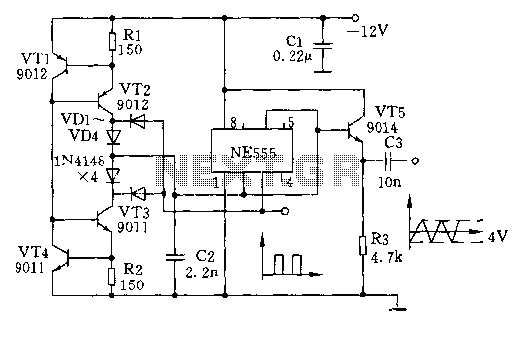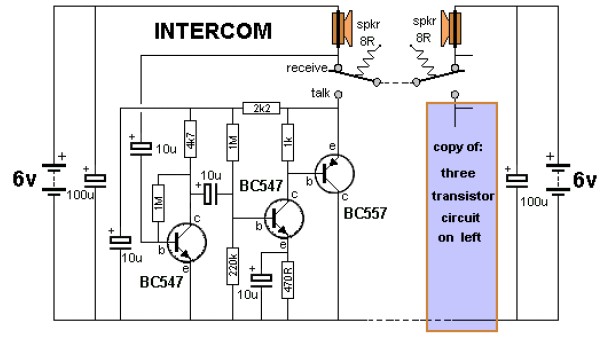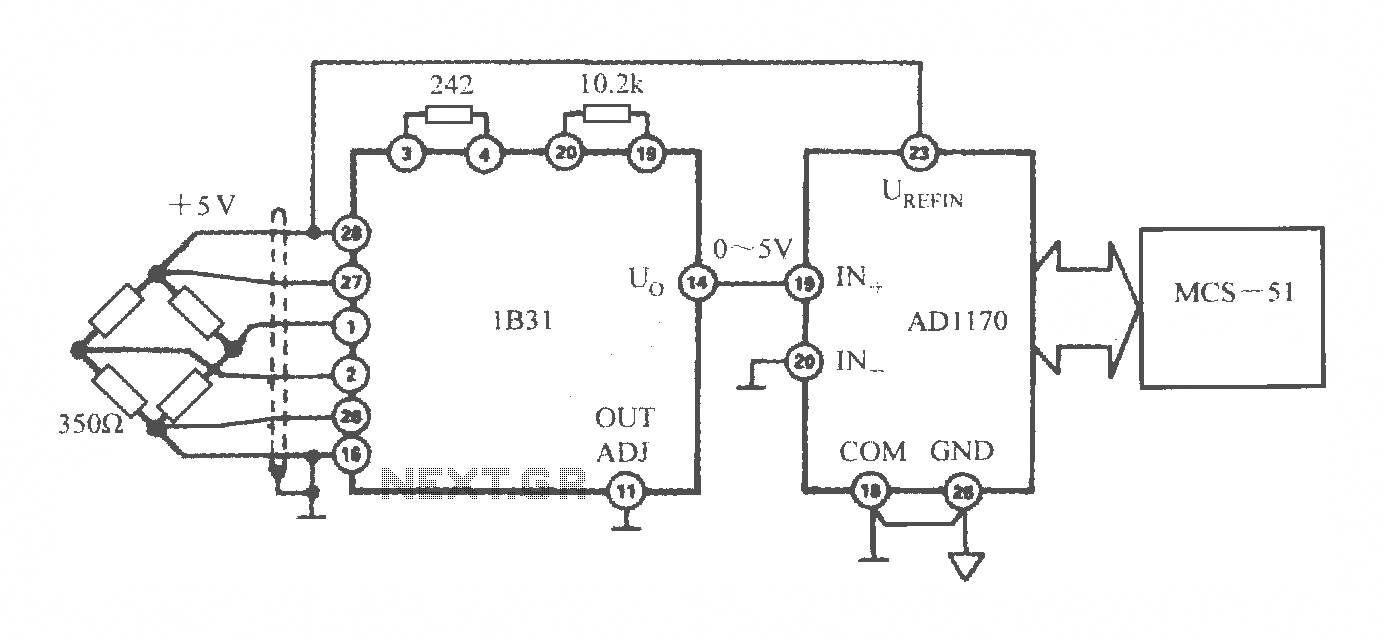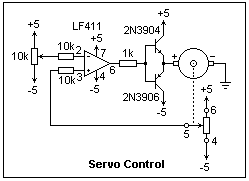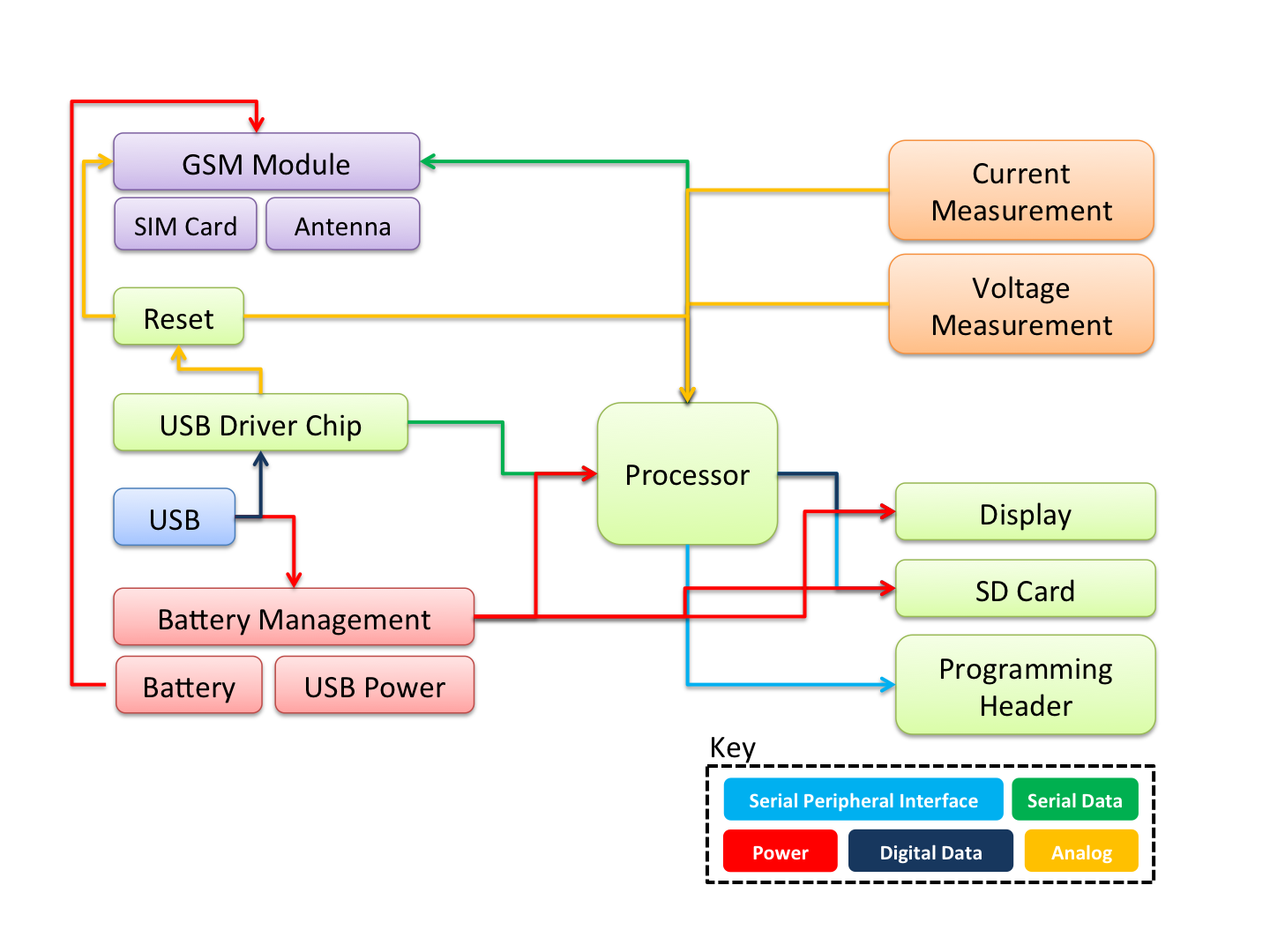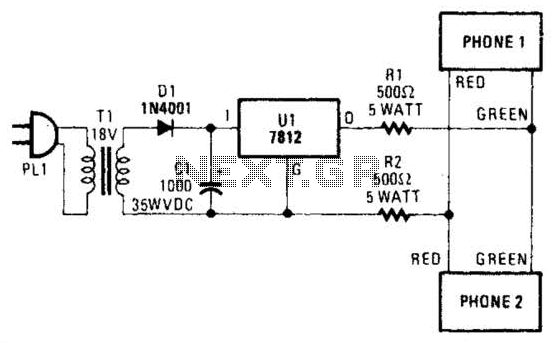
Bi-directional intercom system
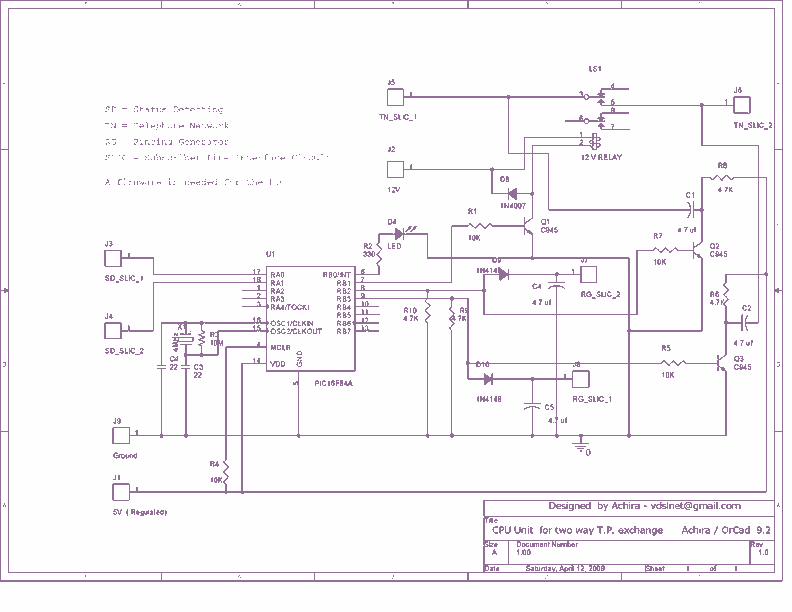

This is a very small telephone exchange attached only two ordinary Tele phones. Fully bi-directional facility with an intercom system. When a phone is in off hook condition, Exchange will detect it & send ringing pulse to other phone. When it will be picked up, the connection will be established between both phones. This will be taken place vice-versa. More: This is used normal step down transformer (400ma) for generating three type of deference voltages & 100 AC volt for rigging. It doesn’t provided a PCB pattern for the power supply unit. So a Vero board can be used to build the unit.
Parts List:
1. Step down transformer (230 V to 30 V, 15 V & 100 V)
2. Two bridged 1 A rectifiers
3. 7805 – 5V regulator
4. 7812 – 12V regulator
5. 1000 µF – 35 V
6. 1000 µF – 16 V
7. 150 mA fuse & its holders
8. Necessary wires & a wire code for AC supply
This circuit is based on the PIC16F84A microcontroller, which provides the logic control necessary for the telephone exchange operation. The design incorporates two Subscriber Line Interface Circuits (SLICs) connected to the microcontroller, allowing for the detection of off-hook conditions and the generation of ringing signals.
The step-down transformer is critical for converting the mains voltage (230 V AC) to lower AC voltages (30 V, 15 V, and 100 V), which are required for different parts of the circuit. The transformer has a rating of 400 mA, which is sufficient for the low-power requirements of the telephone exchange system. The AC output from the transformer is then rectified using two 1 A bridge rectifiers, which convert the AC to DC for use by the microcontroller and other components.
The circuit requires regulated power supplies, which are provided by the 7805 and 7812 voltage regulators. The 7805 regulator provides a stable 5 V output, which is essential for the microcontroller's operation, while the 7812 regulator supplies 12 V for other components that may require higher voltage. The capacitors (1000 µF rated at 35 V and 1000 µF rated at 16 V) are used for filtering and smoothing the output from the rectifiers to ensure stable voltage levels.
A 150 mA fuse is included in the design to protect the circuit from overcurrent conditions, ensuring safe operation. All components are connected using necessary wires, and a wire code is provided for the AC supply connections, ensuring proper installation and functionality.
Due to the absence of a printed circuit board (PCB) design for the power supply unit, a Vero board is recommended for assembling the circuit. This allows for flexibility in component placement and ease of modification if necessary. The overall design ensures a reliable and efficient telephone exchange system suitable for small-scale applications.This is a very small telephone exchange attached only two ordinary Tele phones. Fully bi-directional facility with an intercom system. When a phone is in off hook condition , Exchange will detect it & send ringing pulse to other phone. When it will be picked up , the connection will be established between both phones. This will be taken place vice-versa. This is used normal step down transformer (400ma) for generating three type of deference voltages & 100 AC volt for rigging. It doesn?t provided a PCB pattern for the power supply unit. So a Vero board can be used to build the unit. Parts List : 1.Step down transformer ( 230 V to 30 V , 15 V & 100 V ) 2.Two bridged 1 A rectifiers 3.7805 ?
5V regulator 4.7812 ? 12V regulator 5.1000 uf ? 35 V 6.1000 uf ? 16 v 7.150 ma fuse & it?s holders. 8.Necessary Wires & a wire code for AC supply. This circuit is base on PIC16F84A microcontroller. Two slimier SLIC are connected to The controlling unit. It needs to identify following connections on the controlling unit circuit diagram. This is used normal step down transformer (400ma) for generating three type of deference voltages & 100 AC volt for rigging. It doesn?t provided a PCB pattern for the power supply unit. So a Vero board can be used to build the unit. Parts List : 1.Step down transformer ( 230 V to 30 V , 15 V & 100 V ) 2.Two bridged 1 A rectifiers 3.7805 ?
5V regulator 4.7812 ? 12V regulator 5.1000 uf ? 35 V 6.1000 uf ? 16 v 7.150 ma fuse & it?s holders. 8.Necessary Wires & a wire code for AC supply. 🔗 External reference
Parts List:
1. Step down transformer (230 V to 30 V, 15 V & 100 V)
2. Two bridged 1 A rectifiers
3. 7805 – 5V regulator
4. 7812 – 12V regulator
5. 1000 µF – 35 V
6. 1000 µF – 16 V
7. 150 mA fuse & its holders
8. Necessary wires & a wire code for AC supply
This circuit is based on the PIC16F84A microcontroller, which provides the logic control necessary for the telephone exchange operation. The design incorporates two Subscriber Line Interface Circuits (SLICs) connected to the microcontroller, allowing for the detection of off-hook conditions and the generation of ringing signals.
The step-down transformer is critical for converting the mains voltage (230 V AC) to lower AC voltages (30 V, 15 V, and 100 V), which are required for different parts of the circuit. The transformer has a rating of 400 mA, which is sufficient for the low-power requirements of the telephone exchange system. The AC output from the transformer is then rectified using two 1 A bridge rectifiers, which convert the AC to DC for use by the microcontroller and other components.
The circuit requires regulated power supplies, which are provided by the 7805 and 7812 voltage regulators. The 7805 regulator provides a stable 5 V output, which is essential for the microcontroller's operation, while the 7812 regulator supplies 12 V for other components that may require higher voltage. The capacitors (1000 µF rated at 35 V and 1000 µF rated at 16 V) are used for filtering and smoothing the output from the rectifiers to ensure stable voltage levels.
A 150 mA fuse is included in the design to protect the circuit from overcurrent conditions, ensuring safe operation. All components are connected using necessary wires, and a wire code is provided for the AC supply connections, ensuring proper installation and functionality.
Due to the absence of a printed circuit board (PCB) design for the power supply unit, a Vero board is recommended for assembling the circuit. This allows for flexibility in component placement and ease of modification if necessary. The overall design ensures a reliable and efficient telephone exchange system suitable for small-scale applications.This is a very small telephone exchange attached only two ordinary Tele phones. Fully bi-directional facility with an intercom system. When a phone is in off hook condition , Exchange will detect it & send ringing pulse to other phone. When it will be picked up , the connection will be established between both phones. This will be taken place vice-versa. This is used normal step down transformer (400ma) for generating three type of deference voltages & 100 AC volt for rigging. It doesn?t provided a PCB pattern for the power supply unit. So a Vero board can be used to build the unit. Parts List : 1.Step down transformer ( 230 V to 30 V , 15 V & 100 V ) 2.Two bridged 1 A rectifiers 3.7805 ?
5V regulator 4.7812 ? 12V regulator 5.1000 uf ? 35 V 6.1000 uf ? 16 v 7.150 ma fuse & it?s holders. 8.Necessary Wires & a wire code for AC supply. This circuit is base on PIC16F84A microcontroller. Two slimier SLIC are connected to The controlling unit. It needs to identify following connections on the controlling unit circuit diagram. This is used normal step down transformer (400ma) for generating three type of deference voltages & 100 AC volt for rigging. It doesn?t provided a PCB pattern for the power supply unit. So a Vero board can be used to build the unit. Parts List : 1.Step down transformer ( 230 V to 30 V , 15 V & 100 V ) 2.Two bridged 1 A rectifiers 3.7805 ?
5V regulator 4.7812 ? 12V regulator 5.1000 uf ? 35 V 6.1000 uf ? 16 v 7.150 ma fuse & it?s holders. 8.Necessary Wires & a wire code for AC supply. 🔗 External reference
